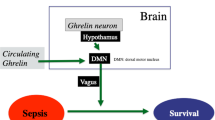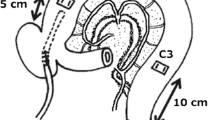Abstract
The underlying mechanisms involved in endotoxin-induced inhibition of gastric acid secretion were investigated in conscious rats with pylorus ligation for 2 hr. Intraperitoneal injection of endotoxin (0.1, 1, and 5 µg/rat) inhibited gastric acid output by 31%, 80%, and 84% respectively. Intraperitoneal endotoxin (1 µg/rat) -induced inhibition of gastric acid secretion was not altered by pretreatment with the interleukin-1 receptor antagonist, IL-1RA, indomethacin, naloxone, or capsaicin. Treatments were injected peripherally at doses previously shown to antagonize the antisecretory effect of exogenous interleukin-1β, to inhibit prostaglandin synthesis in the stomach and brain, to block opiate receptors, and to alter functioning of unmyelinated afferent nerve fibers. These results indicate that the antisecretory effect of endotoxin can be expressed by factors other than interleukin-1, prostaglandins, or opioid peptides that do not require the integrity of capsaicin-sensitive afferent pathways.
Similar content being viewed by others
References
Bhalla S, Vij JC, Anand BS, Varghese A, Chuttani HK: Gastric acid secretion in patients with typhoid fever. Gut 26:491–494, 1985
Impicciatore M, Hansen DG, Rachmilewitz D, Maitra SK, Lugaro G, Grossman MI: Comparison of human urine gastric inhibitor (HUGI) and bacterial endotoxin as inhibitors of acid secretion. Eur J Pharmacol 65:365–368, 1980
Uehara A, Okumura T, Sekiya C, Okamura K, Takasugi Y, Namiki M: Interleukin-1 inhibits the secretion of gastric acid in rats: Possible involvement of prostaglandin. Biochem Biophys Res Commun 162:1578–1584, 1989
Tsuji K, Uehara A, Okumura T, et al: The gastric antisecretory action of lipopolysaccharide is blocked by indomethacin. Eur J Pharmacol 210:213–215, 1992
Uehara A, Okumura T, Tsuji K, et al: Evidence that gastric antisecretory action of lipopolysaccharide is not due to a toxic effect on gastric parietal cells. Dig Dis Sci 37:1039–1044, 1992
Ulich TR, Guo K, Irwin B, Remick DG, Navatelis GN: Endotoxin-induced cytokine gene expression in vivo. Am J Pathol 137:1173–1185, 1990
Sirko S, Bishai I, Coceani F: Prostaglandin formation in the hypothalamusin vivo: Effect of pyrogens. Am J Physiol 256:R616-R624, 1989
Zuckermam SH, Shellhaas J, Butler LD: Differential regulation of lipopolysaccharide-induced interleukin-1 and tumor necrosis factor synthesis: effects of endogenous and exogenous glucocorticoids and the role of pituitary-adrenal axis. Eur J Immunol 19:301–307, 1989
Raymond RM, Harkema JM, Stoffs WV, Emerson TE: Effects of naloxone therapy on hemodynamics and metabolism following a superlethal dosage ofEscherichia coli endotoxin in dogs. Surg Gynecol Obstet 152:159–162, 1981
Ebisui O, Fukata J, Tominaga T, et al: Role of interleukin-1α and -1β in endotoxin-induced suppression of plasma gonadotropin levels in rats. Endocrinology 130:3307–3313, 1992
Rivier C, Chizzonite R, Vale W: In the mouse, the activation of the hypothalamic-pituitary-adrenal axis by a lipopolysaccharide (endotoxin) is mediated through interleukin-1. Endocrinology 125:2800–2805, 1989
Long NC, Otterness I, Kunkel SL, Vander AJ, Kluger MJ: Roles of interleukin 1β and tumor necrosis factor in lipopolysaccharide fever in rats. Am J Physiol 259:R724-R728, 1990
Hamilton AJ, Carr DB, Larovere JM, Black PMCL: Endotoxic shock elicits greater endorphin secretion than hemorrhage. Circ Shock 19:47–54, 1986
Carr DB, Bergland R, Hamilton A, et al: Endotoxin-stimulated opioid peptide secretion: Two secretory pools and feedback controlin vivo. Science 217:845–848, 1982
Rees M, Payne JG, Bowen JC: Naloxone reverses tissue effects of liveEscherichia coli sepsis. Surgery 91:81–86, 1982
Lundberg JM, Franco-Cereceda A, Alving K, Delay-Goyet P, Lou Y-P: Release of calcitonin gene-related peptide from sensory nerve. Ann NY Acad Sci 657:187–193, 1992
Saperas E, Yang H, Rivier C, Taché Y: Central action of recombinant interleukin-1 to inhibit acid secretion in rats. Gastroenterology 99:1599–1606, 1990
Ishikawa T, Nagato S, Ago Y, Takahashi K, Karibe M: The central inhibitory effect of interleukin-1 on gastric acid secretion. Neurosci Lett 119:114–117, 1990
Wallace JH, Keenan CM, Cucala M, Mugridge KG, Parente L: Mechanisms underlying the protective effects of interleukin 1 in experimental nonsteroidal anti-inflammatory drug gastropathy. Gastroenterology 102:1176–1185, 1992
Saperas E, Cominelli F, Taché Y: Potent inhibition of gastric acid secretion by intravenous interleukin-1β and -1α in rats. Peptides 13:221–226, 1992
Robert A, Olafsson AS, Lancaster C, Zyang WR: Interleukin-1 is cytoprotective, antisecretory, stimulates PGE2 synthesis by the stomach, and retards gastric emptying. Life Sci 48:123–134, 1991
Wallace JL, Cucala M, Mugridge K, Parente L: Secretagogue-specific effects of interleukin-1 on gastric acid secretion. Am J Physiol 261:G559-G564, 1991
Saperas E, Kauffman G, Taché Y. Role of central prostaglandin E2 in the regulation of gastric acid secretion in the rat. Eur J Pharmacol 209:1–7, 1991
Fox DA, Burks TF: Roles of central and peripheral mu, delta and kappa opioid receptors in the mediation of gastric acid secretory effects in the rat. J Pharmacol Exp Ther 244:456–462, 1988
Taché Y: Inhibition of gastric acid secretion and ulcers by calcitonin gene-related peptide. Ann NY Acad Sci 657:240–247, 1992
Hannum CH, Wilcox CJ, Arend WP, et al: Interleukin-1 receptor antagonist activity of a human interleukin-1 inhibitor. Nature 343:336–340, 1990
Dinarello CA, Thompson RC: Blocking IL-1: interleukin 1 receptor antagonistin vivo andin vitro. Immunol Today 12:404–410, 1991
Lenz JH, Marvin MR: Central nervous system actions of β-endorphin on gastric acid secretion. Brain Res 413:1–9, 1987
Holzer P: Capsaicin: Cellular targets, mechanisms of action, and selectivity for thin sensory neurons. Pharmacol Rev 43:143–201, 1991
Pique JM, Yonei Y, Whittle BJR, Leung FW, Guth PH: Indomethacin potentiates endotoxin-induced blood flow reduction and histological injury in rat gastric mucosa. Br J Pharmacol 93:925–931, 1988
Wallace JL: Gastrointestinal plasma leakage in endotoxin shock. Inhibition by prostaglandin E2 and a platelet-activating factor antagonist. Can J Physiol Pharmacol 65:1428–1432, 1987
Lieberman AP, Pitha PM, Shin HS, Shin ML: Production of tumor necrosis factor and other cytokines by astrocytes stimulated with lipopolysaccharide or a neurotropic virus. Proc Natl Acad Sci USA 86:6348–6352, 1989
Katsuura G, Gottschall PE, Arimura A: Identification of a high-affinity receptor for interleukin-1 beta in rat brain. Biochem Biophys Res Commun 156:61–67, 1988
Saperas E, Yang H, Taché Y: Interleukin-1β acts at hypothalamic sites to inhibit gastric acid secretion in rats. Am J Physiol 263:G414-G418, 1992
Saperas E, Taché Y. Central interleukin-1β-induced inhibition of acid secretion in rats: Specificity of action. Life Sci 52:785–792, 1993
Schweigerer L: Endotoxin-induced formation of specific β-endorphin binding sites in human serum. Biochem Biophys Res Commun 113:839–844, 1983
Sternini C: Enteric and visceral afferent CGRP neurons: Targets of innervation and differential expression patterns. Ann NY Acad Sci 657:170–186, 1992
Author information
Authors and Affiliations
Additional information
Supported by the National Institute of Arthritis Metabolism and Digestive Disease, grant DK-30110, and the Institute of Mental Health, grant MH-00663, a Research Grant from the Psychoneuroimmunology Program at UCLA, and the “Direction General de Investigacion Cientificas Y Técnicas” (DGICYT PM—0124 to Dr. E. Saperas).
Rights and permissions
About this article
Cite this article
Saperas, E., Taché, Y. Interleukin-1 receptor antagonist does not prevent endotoxin-induced inhibition of gastric acid secretion in rats. Digest Dis Sci 39, 152–156 (1994). https://doi.org/10.1007/BF02090075
Received:
Revised:
Accepted:
Issue Date:
DOI: https://doi.org/10.1007/BF02090075




